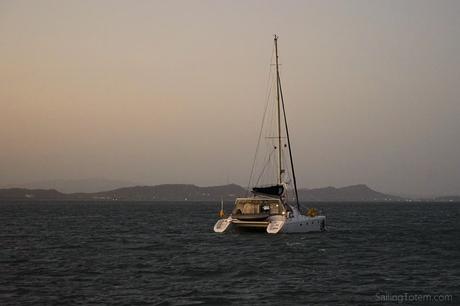
Losing steerage is stressful at the best of times. Losing it when hand-steering gnarly seas that threaten to broach the inattentive sailor, on day one of a four-day sail between countries where the sea state is likely to be worse before it’s better? Hectic! Here’s what happened when steering failed on our recent passage from Colombia to Panama.
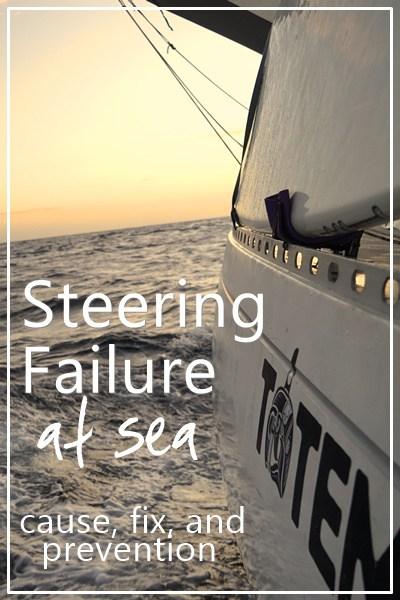 The event
The event

Motoring out of the protection in Santa Marta bay (with a small deviation from course to rubberneck the 185’ yacht, M5, pictured above), we quickly entered more boisterous conditions outside the protection of the bay. Steep waves were better managed with hand steering; Jamie worked the helm. Just a few hours out of Santa Marta, Colombia, Totem lurched after a loud bang from the guts of the boat. “We have no steerage!” Jamie called out from the cockpit, instantly in motion.
He dove for the autopilot controls at the companionway: guessing, correctly, that the autopilot would still drive the rudder. Sure enough, it worked and Totem was under control again.
Braced in the nav station, I called to Utopia II over the VHF to let them know our situation. They were just a few miles away—we expected to remain in proximity to them for the duration, and knowing they would be nearby to render aid if necessary was comforting.
Niall worked the autopilot while Jamie set up our emergency tiller. Being ready for the next level of events can mean the difference between difficulty and crisis. Our concern was that heavy seas would overwork our old Raymarine and cause the autopilot to fail. It happened before: four years ago this month, we lost the autopilot, then the eye-bolt that secures steering cable to quadrant broke, THEN the engine overheated- trifecta!
The focus: limiting this event to a single problem. Driving Totem with the emergency tiller is hard work in calm conditions. With our bigger rudder, as Jamie says—using the tiller is like steering a loaded dump-truck without a wheel!
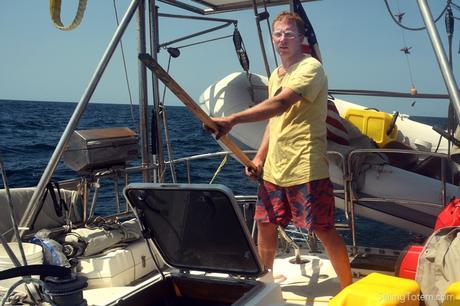
February 2014: steering with the emergency tiller in Thailand
The cause
With Totem under autopilot control, Jamie started troubleshooting. He began at the quadrant. Eye bolts and cable looked fine. Then followed the steering cable forward until it turns on a sheave upward to the binnacle. Bingo! One cable did not look like the other.
The cause was the weakest link, literally. The steering system is comprised of a length of chain that meshes with the sprocket fixed to the steering wheel. Each chain end has a link that secures to the swaged eye at the end of the steering cable. This last link is different than the others. It has a sir clip that allows the link to open to lock the swage eye in place. The link broke under that sir clip, due to stainless steel crevice corrosion. Jamie inspected the system just a year ago (with 7x magnifying glass), but as is often the case with stainless steel, you cannot see all of the surfaces where a sign of pending doom may lurk.
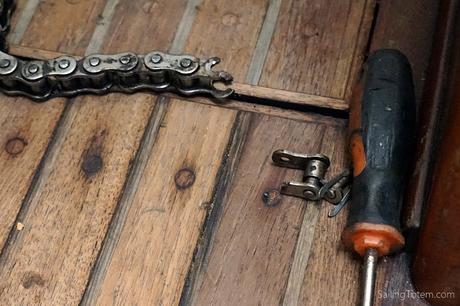
The weakest link
The fix
Conditions were tough: square-faced breaking seas of 3 to 5 meters. These were the steepest wave we’ve experienced. Using the autopilot with constant adjustments kept us well in control. We touched 13.2 knots a couple times without any dramas, but always ready to jump to the emergency tiller.
After 60 miles in those waves and wind from 25 to 40 knots, we anchored that evening at Puerto Velero, just west of Barranquilla. Nice relief to be in safe harbor, but the day was not over. With the miles and conditions ahead of us, we wanted steering back on line. Earlier in the day, while calling out “plus ten, now go minus ten” to help Niall work the autopilot for steering the waves, Jamie thought through possible solutions. We have spare steering cables, but no spare chain. The solution was one of his favorite materials – DYNEEMA!
Working on repairs by headlamp-light, he removed chain and cables. Then spliced 6mm single-braid Dyneema to the last chain pin to run in place of the wire cable. By 10 that night, the linkage was reinstalled and adjusted. There is chance the quadrant or sheaves may chafe the Dyneema; or the chain pin with Dyneema around it may distort or break. We’re monitoring it and is all good, three weeks and 326 nautical miles so far.
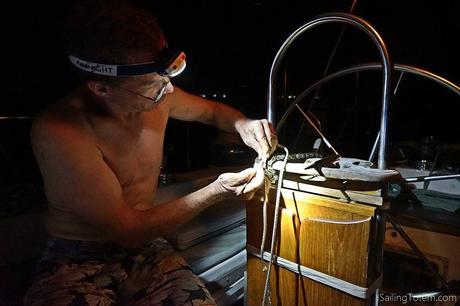
Splicing by headlamp-light
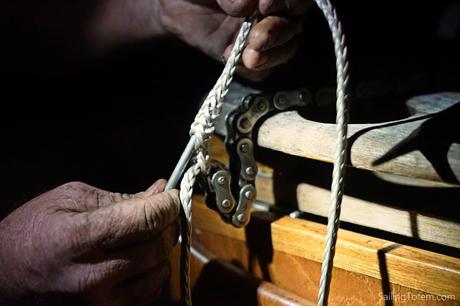
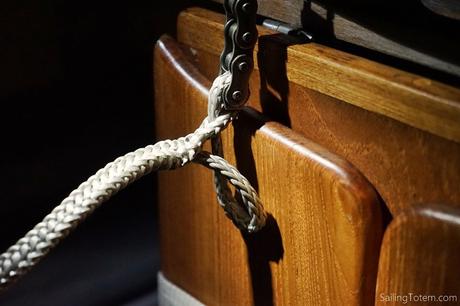

The evening was interrupted by a visit from Maritime Police, an event I’d sooner put in hindsight (details, this post). Happy to leave the harbor the next morning, we motored out behind the Aussie cat, Aseka, in the mellow light of dawn and continued to Panama.
